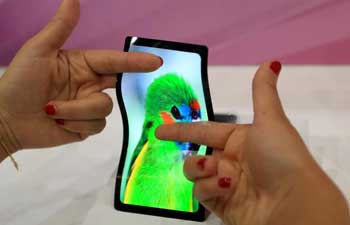WASHINGTON, May 24 (Xinhua) -- American researchers have developed an ingestible sensor equipped with genetically engineered bacteria, which can diagnose bleeding in the stomach or other gastrointestinal problems.
According to a study published on Thursday in the journal Science, this "bacteria-on-a-chip" approach combined sensors made from living cells with ultra-low-power electronics that converted the bacterial response into a wireless signal that could be read by a smartphone.
"By combining engineered biological sensors together with low-power wireless electronics, we can detect biological signals in the body and in near real-time, enabling new diagnostic capabilities for human health applications," said the paper's co-senior author Timothy Lu, an associate professor of biological engineering at Massachusetts Institute of Technology (MIT).
According to the paper, sensors can respond to heme, a component of blood, and they work in pigs. Researchers also designed sensors that can respond to a molecule called thiosulfate, a marker of inflammation.
Previously, synthetic biologists engineered bacteria to respond to stimuli such as environmental pollutants or markers of disease, by producing outputs like light, but specialized lab equipment is usually required to measure this response.
"Our idea was to package bacterial cells inside a device," said Phillip Nadeau, the paper's co-lead author and a former MIT postdoc. "The cells would be trapped and go along for the ride as the device passes through the stomach."
At first, the researchers engineered a probiotic strain of E. coli to express a genetic circuit that causes the bacteria to emit light when they encounter heme.
Then they placed the bacteria into four wells on their custom-designed sensor, covered by a semipermeable membrane that allows small molecules from the surrounding environment to diffuse through.
Underneath each well is a phototransistor that can measure the amount of light produced by the bacterial cells and relay the information to a microprocessor that sends a wireless signal to a nearby computer or smartphone.
The researchers also built an Android app that can be used to analyze the data.
The sensor, which is a cylinder about 3.8 centimeters long, requires about 13 microwatts of power. The researchers equipped the sensor with a 2.7-volt battery, which they estimate could power the device for about 1.5 months of continuous use. It could also be powered by a voltaic cell sustained by acidic fluids in the stomach, according to the researchers.
The researchers tested the ingestible sensor in pigs and showed that it could correctly determine whether any blood was present in the stomach. They anticipated that this type of sensor could be either deployed for one-time use or designed to remain the digestive tract for several days or weeks, sending continuous signals.
Currently, if people are suspected to be bleeding from a gastric ulcer, they have to undergo an endoscopy to diagnose the problem, which often requires the patient to be sedated.
To help move the technology toward patient use, the researchers plan to reduce the size of the sensor and to study how long the bacteria cells can survive in the digestive tract. They also hope to develop sensors for gastrointestinal conditions other than bleeding.
"Right now, we have four detection sites, but if you could extend it to 16 or 256, then you could have multiple different types of cells and be able to read them all out in parallel, enabling more high-throughput screening," said Nadeau.

















